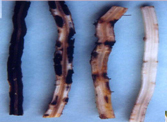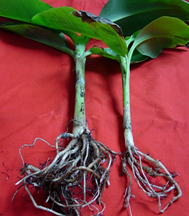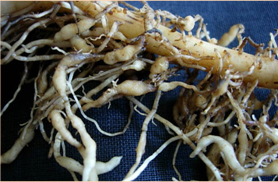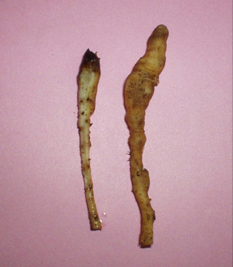Nematode pest of Citrus
Citrus nematode: Tylenchulus semipenetrans
Symptoms
- Leaves become smaller and chlorotic
- Leaf drop is more pronounced producing exposed branch terminals.
- Early wilting during water stress.
- Poor root development.
- Dirty appearance of infected roots.
- Faster decay of feeder roots.
- Root death due to heavy infestation.
- Infested trees are smaller and less productive than normal ones.
Management
- Avoidance of infested planting materials and contaminated farm implements.
- Provision of adequate light and water drainage
- Use of resistant root stock.
- Pre-plant application of carbofuran 3 G 100g/tree
- Application of Pseudomonas fluorescens @ 20 g tree.
Banana
Burrowing nematode: Radopholus similis
- Stunting of plants
- Reduction in size and number of leaves and in bunch weight.
- Appearance of dark red lesion on roots.
- Toppling of plants in windstorms or heavy rains.
|
|
|
Affected root portion |
|
Affected field |
Lesion nematode: Pratylenchus coffeae
Symptoms
- Extensive black or purple necrosis on roots
- Stunting of plants.
- Reduction in size and number of leaves and in bunch weight.
Management
- Fallowing for a period of six months or longer.
- Crop rotation with non-host crops.
- Use of disease free planting material.
- Storage of large corms in the sun for two weeks prior to planting.
- Use of cover crop calapogonium.
- Removal of infested portions of corm before planting.
- Hotwater treatment at 55o C for 15-25min.
- Paring and Pralinage
- Carbofuran 3 g @40g/ plant at 90 days after planting.
- Application of neem cake
Host: Grapevine, Papaya, Pomegranate ,Banana
l
Root-knot nematodes: Meloidogyne spp. and Reniform nematode: Rotylenchulus reniformis
Symptoms
- Unthrifty growth
- Susceptibility to growth, often occurring in patches.
- Reduced yield.
- Heavily infested plants have a much reduced root system with large elongated galls in root-knot infested plants.
- Small galls along feeder roots in root-knot infested plants.
|
|
|
Infected Papaya root |
Infected pomegranate root |
Infected pomegranate field |
Management
- Planting stocks certified free of infection.
- Application of carbofuran 3G @ 60g/vine.
- Application of Pseudomonas fluorescens @ 50g/vine.
|






